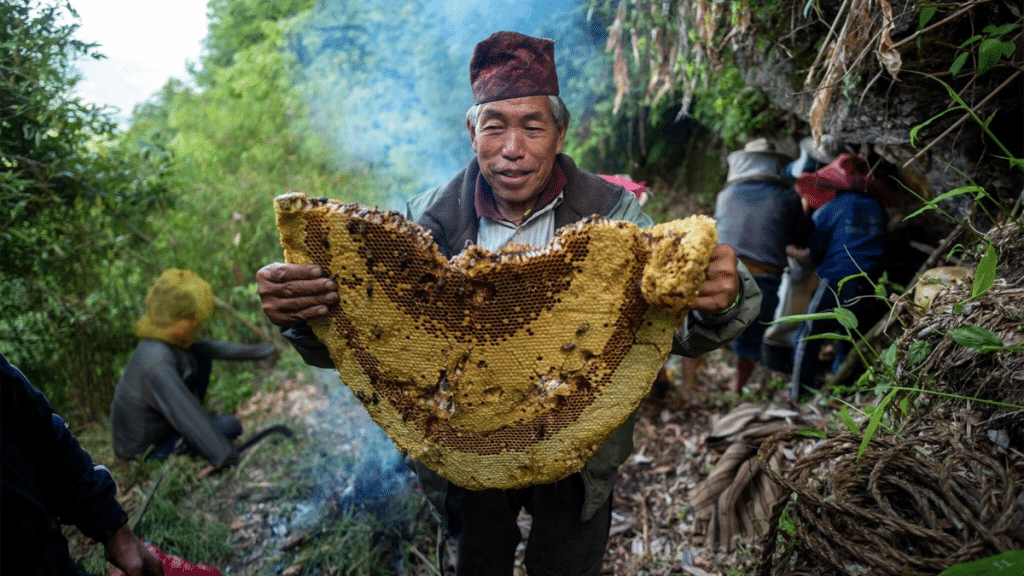In Nepal it is quite risky to see a Gurung widely known as the Honey Hunter from the Himalayas dangling on the ropes and is prepared to harvest honey using traditional tools. Even riskier is the high cliffs from where these Gurungs harvest the honey for personal use and livelihood. The cliffs sometimes as high as the sky is home of the bees widely known as the Himalayan Giant bees of the wild. The entire process of honey hunting is quite challenging as a minor mistake can cost the lives of hunters and other involved members during the hunt. This practice has been deeply entwined with the Gurungs where their bravery, courage and skill have established a deep connection with nature. Although the tradition and skill has been passed down from one generation to another, modernization is changing the lives of Gurung Honey Hunters.
The Practice of Honey Hunting
The Gurungs of the Himalayas choose Honey Hunting not just as a means of earning a livelihood but also a way to pay homage to their ancestors. The wild cliff honey or widely known as Mad Honey for its psychoactive properties harvesting and use ensured the continuation of this ancient art for future generations. But bravery, skill and courage alone are not enough to harvest this honey from the wild, one needs strategy, physical endurance and technical knowledge to obtain this precious elixir. Although modernization has already started to impact these honey hunters they still rely upon traditional tools made up of wood, bamboo and dried leaves. These are locally available, sustainable and environment friendly.
While smoke calms the bees by neutralizing the pheromones, a chemical they release to signal other bees for defense. Still some bees find a way to sting the hunters which can be painful and can challenge the honey hunter during the process. Even a small mistake can result in injury and death thus this harvesting process needs precision and accuracy.
Honey hunting is not just about the harvest of this wild honey from the high cliffs, rather it is a cultural practice of the Gurungs connected with the ecological balance of nature. The hunters understand the role of these bees in pollinating the Himalayan ecosystem. They have been praying to the bees as a form of god for maintaining the Himalayan lifecycle and nature’s balance. They keep the harvesting process in accordance with the bees sustainability where a portion of honey comb is left untouched for the brood and other small bees to thrive and continue generations. This respectful relationship is a hallmark of practice and it is what keeps the relationship between the hunters and environment in equilibrium.
Honey Hunting in Nepal
The cliff honey harvesting or widely known as honey hunting from an adventure point of view has been practiced in several parts of the world. Although several countries are reported to have been practicing the art of honey harvesting, Nepal is specially renowned for harvesting wild cliff honey. The Himalayan giant honeybee (Apis Laboriosa) are the native bees to the Himalayan country Nepal and are famous for producing Mad Honey. This practice of honey harvesting is completely traditional and involves meticulous rituals, prayers, animal sacrifice and songs to honor the bees and the ancient spirits.
The Decline of Honey Hunting in Nepal
Despite its ancient history and connection with nature, honey hunting culture is declining. The tribes are losing leaders to lead the honey hunting as the last leader who fell off the cliff never wake up. Some no longer have strength to endure the cliffs or have grown too old and for some tribes, young generations don’t want to follow their father’s footsteps. They think tradition no longer serve their purpose and they seek education and better employment opportunities for alternative livelihoods. Also, natural pressure like deforestation and climate changes are major reasons that contribute to decline of rhododendron plants. The low availability of rhododendron plants directly impacts honey production and less hives can sustain. Lesser hives demotivates the honey hunters of the region or encourages harvesters for over harvesting of the existing hives found in the region.
Efforts are being made in terms of cultural and ecological activity to preserve honey hunting activity. Ethnographers, conservationists and local communities are working to document the knowledge, promote sustainable practices and draw attention to the importance of wild bees. “Companies like Medicinal Mad Honey are trying to preserve the culture by keeping direct contact with the honey hunting community,” says Rashmi Kandel, Founder and Author of Medicinal Mad Honey. They are leading the expedition and tours of Honey Hunting where tourists can experience the adventure along with taste the wilderness straight from the hive. They want to share with the world that these Himalayan bees of Nepal are extremely important for Himalayan ecosystem and needs global attention for the preservation and protection.
Why Honey Hunting Matters
Honey Hunting is more than harvesting of wild honey from the high cliffs of Nepal. It is a proof that cultural roots of humans have intrinsic relation with nature and vice versa. The Gurung honey hunters believe that the wild bees are not there just for honey and supporting the Gurung Lifestyle. But these bees are equally important for ecological balance and nature sustainability in the Himalayan region.
They have understood the butterfly effect where one ecological disturbance in the small part of Nepal can have adverse effects on the global ecosystem. It is for them that the legacy of Honey Hunting and protection of these bees is extremely crucial for biodiversity. Thus, a global attention for the nature conservation seems important.

